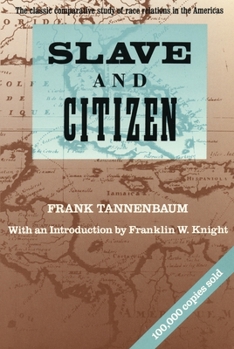Slave and Citizen: The Classic Comparative Study of Race Relations in the Americas
Select Format
Select Condition 
Book Overview
Originally published in 1947, Slave and Citizen is a classic in the field of comparative slave history and race relations. This description may be from another edition of this product.
Format:Paperback
Language:English
ISBN:080700913X
ISBN13:9780807009130
Release Date:February 1992
Publisher:Beacon Press
Length:160 Pages
Weight:0.90 lbs.
Dimensions:0.4" x 5.0" x 8.0"
Customer Reviews
1 rating
The Justianian Code versus The Black Codes
Published by Thriftbooks.com User , 16 years ago
In my own writings, I have been of the opinion that the "Rosetta Stone" of American racism and its subsequent race problems, lies very much in the way its slave system was constructed, and then in the cataclysmic way in which it was dismantled - meaning as a result of the Civil War. Always, to my mind, what seemed missing was a sufficiently robust "control case" against which to actually measure the depth of the actual cruelty and lingering effects of the American version of slavery. In this book, first published in 1948, I think I have finally found the perfect "control case." Since slavery in Brazil came about in pretty much the same way, at the same time, and lasted for roughly the same length, as that in the U.S, the differences between the two can serve as an appropriate backdrop to study each in the reflected light of the other. And it is here that Professor Tannenbaum has made my work easier as he has done most of it for me. What he has done basically is end the sterile U.S. debate over whether the slave was Just a "contented child" forever grateful to his masters for having saved him from Africa and condemnation to moral and cultural oblivion, or was indeed the victim of an inhumane system unique in the annals of human history in its utter and thorough brutality. With this work as backdrop, it is clear enough to see that it was indeed the latter. Among many other questions, Professor Tannenbaum's book answers directly the question: Why, since slavery was introduced in both countries at the same time and lasted for roughly the same period, are there only a few racial problems in Brazil and so many in the U.S.? His answer gets directly to the heart of the matter: that the Spanish and Portuguese versions of slavery, even though also oppressive, through the Catholic Justinian Code, granted the slave a moral life and personality, while the U.S. version through America's many Black Codes, did not. In Brazil, however tenuously, the slave was granted his humanity and moral equality to the slave owner. In the U.S. there was nothing corresponding to the Justinian Code, and Christianity, as practiced by Americans, along with the many U.S. "Black Codes," were used to further justify the brutality of slavery and to further dehumanize the slave rather than to grant him moral equality. Forced to choose between seeing the slave as a human being or as property, the imperatives of economics buttressed by a perverse brand of Christianity, the American Christian nation chose the latter: that is, to define the slave as property rather than as a moral human being. (As late as 1978, the Mormon Church had maintained this rather archaic view as part of its theological orthodoxy.) Granting the slave moral equality was an inalienable right according to Brazil's Catholic Justinian Code; while making him forever a heathen under the American version of the Christian doctrine and through a patchwork of "Black Codes," ensured that his soul would be forever consi





